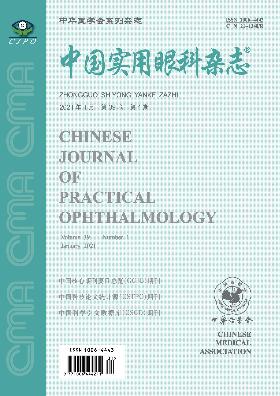Clinical manifestations and MRI imaging features of sphenoid ridge meningiomas in the eye
引用次数: 0
Abstract
Objective To investigate the clinical manifestation, MRI imaging features and visual function prognosis of sphenoid wing meningioma in the eyes. Methods A retrospective analyzed of 11 patients with sphenoid wing meningioma diagnosed by surgery, the clinical manifestations, the shape and size of lesions in MRI, the relationship with adjacent tissues, as well as postoperative vision, eyeballs and vision recovery. Results Eleven cases of sphenoid wing meningioma patients, the clinical manifestations of ipsilateral visual acuity decreased in 9 cases, 7 cases of eye protrusion, visual field defect in 6 cases. MRI showed 7 cases of orbital cranial tumor, 4 cases of intracranial tumors, the largest diameter of the tumor 2.3cm-8.2cm. T1WI showed moderate and low signal, T2WI showed moderate and high signal, all tumors were evenly enhanced. Tumor and peripheral brain tissue boundary in 9 cases, border blur in 2 cases. Invasion of the optic nerve caused by optic nerve density, location changes in 7 cases. Surgical approach, including the cranial orbital zygomatic approach and pterional approach, as far as possible during the removal of tumor, postoperative follow-up, visual impairment in postoperative visual acuity improved in 2 cases; in the patients with prominent eyes,3 cases returned to normal after operation,and 4 cases had decreased eyes prominence; 3 cases of postoperative vision improved. Conclusions Sphenoid wing meningioma can occur in all age groups, eye symptoms to vision loss, eyeballs, visual field defects, MRI imaging of T1WI mostly moderate and low signal, T2WI is medium and high signal. The tumor density is more consistent. Postoperative visual acuity depends on the preoperative residual vision, the better the prognosis of vision, the better eyeballs and visual field defects, the better prognosis. Key words: Sphenoid ridge meningiomas; MRI; Clinical Features; Visual function prognosis眼蝶骨嵴脑膜瘤的临床表现及MRI影像特征
目的探讨眼蝶翼脑膜瘤的临床表现、MRI影像特征及视功能预后。方法回顾性分析11例经手术诊断的蝶翼脑膜瘤患者的临床表现、MRI病变形态、大小、与邻近组织的关系以及术后视力、眼球及视力恢复情况。结果11例蝶翼脑膜瘤患者,临床表现为同侧视力下降9例,眼球突出7例,视野缺损6例。MRI示眶部颅脑肿瘤7例,颅内肿瘤4例,肿瘤最大直径2.3cm-8.2cm。T1WI呈中、低信号,T2WI呈中、高信号,各肿瘤均匀增强。肿瘤与周围脑组织边界9例,边界模糊2例。侵犯视神经引起视神经密度、位置改变7例。手术入路包括颅眶颧入路和翼点入路,手术期间尽可能切除肿瘤,术后随访,视力障碍患者术后视力改善2例;眼突出患者术后3例恢复正常,4例眼突出下降;术后视力改善3例。结论蝶翼脑膜瘤可发生于各年龄组,眼部症状以视力减退、眼球、视野缺损为主,MRI成像T1WI多为中、低信号,T2WI多为中、高信号。肿瘤密度更一致。术后视力取决于术前残余视力,视力预后越好,眼球和视野缺损越好,预后越好。关键词:蝶骨嵴脑膜瘤;核磁共振;临床特征;视觉功能预后
本文章由计算机程序翻译,如有差异,请以英文原文为准。
求助全文
约1分钟内获得全文
求助全文
来源期刊
自引率
0.00%
发文量
9101
期刊介绍:
China Practical Ophthalmology was founded in May 1983. It is supervised by the National Health Commission of the People's Republic of China, sponsored by the Chinese Medical Association and China Medical University, and publicly distributed at home and abroad. It is a national-level excellent core academic journal of comprehensive ophthalmology and a series of journals of the Chinese Medical Association.
China Practical Ophthalmology aims to guide and improve the theoretical level and actual clinical diagnosis and treatment ability of frontline ophthalmologists in my country. It is characterized by close integration with clinical practice, and timely publishes academic articles and scientific research results with high practical value to clinicians, so that readers can understand and use them, improve the theoretical level and diagnosis and treatment ability of ophthalmologists, help and support their innovative development, and is deeply welcomed and loved by ophthalmologists and readers.

 求助内容:
求助内容: 应助结果提醒方式:
应助结果提醒方式:


